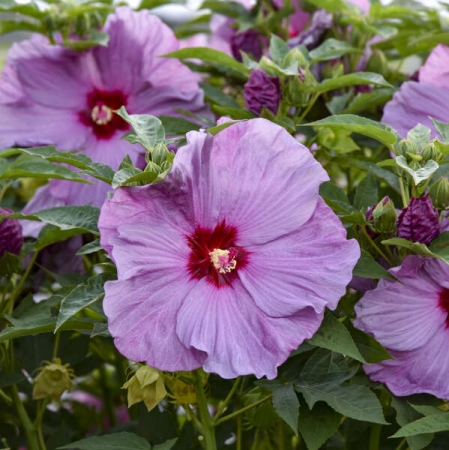Hibiscus (Rose Mallow)
×
Color Name: Lilac Crush
Lilac Crush features a rare color among Hardy Hibiscus! Lilac flowers open 7-8" wide with overlapping petals of a thick substance. The flowers will have cool tones under low temperature conditions. Lilac Crush has an upright, columnar habit that is very sturdy and resists lodging. Maple-like leaves are a rich green.
These North American native plants bring massive, tropical-looking flowers all the way to zone 4. Although later to emerge than most perennials in spring, these are fast growing plants capable of adding an inch of new growth a day. Excellent at brightening up end of season gardens.
Growing Tips: Hibiscus love the sun and need moist, well-drained soil. Keeping these plants watered will result in larger flowers and lush foliage. Deadheading will improve the appearance of the plant. It is best to plant Hibiscus in the garden before the heat of the summer arrives, and should be heavily mulched the first winter. In spring, cut back any remaining stems before new growth appears. A strong pair of loppers or a saw will be necessary to cut this plant back. Be advised that Hibiscus is always one of the last perennials to emerge in spring. Its vigorous growth rate more than makes up for this late start, however. Japanese beetles find these plants especially delicious.
Photo courtesy of Walters Garden, Inc.
Lilac Crush features a rare color among Hardy Hibiscus! Lilac flowers open 7-8" wide with overlapping petals of a thick substance. The flowers will have cool tones under low temperature conditions. Lilac Crush has an upright, columnar habit that is very sturdy and resists lodging. Maple-like leaves are a rich green.
These North American native plants bring massive, tropical-looking flowers all the way to zone 4. Although later to emerge than most perennials in spring, these are fast growing plants capable of adding an inch of new growth a day. Excellent at brightening up end of season gardens.
Growing Tips: Hibiscus love the sun and need moist, well-drained soil. Keeping these plants watered will result in larger flowers and lush foliage. Deadheading will improve the appearance of the plant. It is best to plant Hibiscus in the garden before the heat of the summer arrives, and should be heavily mulched the first winter. In spring, cut back any remaining stems before new growth appears. A strong pair of loppers or a saw will be necessary to cut this plant back. Be advised that Hibiscus is always one of the last perennials to emerge in spring. Its vigorous growth rate more than makes up for this late start, however. Japanese beetles find these plants especially delicious.
Photo courtesy of Walters Garden, Inc.
|
Flower Color: Purple/Red Shades Foliage Color: Green Shades
Height: 5 to 6 Feet Spread: 4 to 5 Feet Hardy in Zone: 4, 5, 6 |
Blooms: Summer to Fall
Foliage Season: All Season |
Growth Rate |
Rapid
|
Attributes |
Native Extended Bloomer Specimen Plant Mass Planting Landscapes Easy to Grow Border Water's Edge
|









